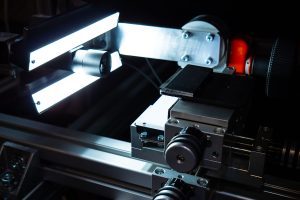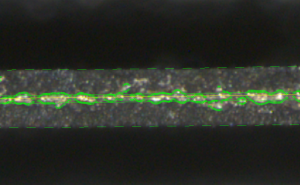Sonplas GmbH in Straubing has been a long-standing partner of the automotive industry. Engineers at the special machinery manufacturer have been implementing innovative projects within the e-mobility sector for over 10 years, and thus contribute to the mobility of the future.
A newly developed method for processing electrodes is one of the innovative projects the company developed. For that matter, Sonplas managed to develop a premium quality laser cutting process to significantly enhance the cut edges of the electrode films to be separated. In addition to this process, Sonplas GmbH is currently working on an inspection module, which evaluates the quality of the battery electrode, in the course of an innovation project.
During the roll-to-roll processing method, the foils are coated with electrode material on the so-called master rolls. The films are subsequently separated on the smaller sub-rolls in order to achieve the required format of the cells before they are cut at the edge (so-called notching process). The notching process is followed by the separation, during which the individual electrode sheets are cut out. In doing so, enhanced cut edges of the electrode films are just one of the many benefits. An optimal laser cut is required to allow the quality level of the batteries produced to be according to the highest standards

The camera as well as the required lighting for the checking of the cut edges in the inspection module of Sonplas GmbH.
To assess this quality level, Sonplas GmbH has now developed an inspection module, which carries out this assessment automatically. In order to ensure this laser cut edge quality, the parameterisation of all components must be synchronised perfectly. After determining the parameters and processing the film, the electrode is checked for various quality criteria. In the past, experts used to take care of this step and carried out the verification under a microscope. Not only was this process time-consuming, but also subjective, and dependent on the expert.
The inspection module allows for checking several crucial criteria automatically. For example, the burr quality of the cut electrodes can be analysed. This is crucial to ensure that no particles can come off in the battery being produced, which could cause a short circuit and thus a defective cell. A swivel arm featuring an installed camera including the necessary lighting also allows to switch between two different perspectives.

0° view in the inspection module: The melt bulge formed in the laser process can be seen.
For example, it allows for testing different properties, which are generated by heat exposure from the laser. This includes, among other things, the heat-affected zone (HAZ). At the same time, the electrode is viewed by the camera from two angles, the 90° view and the 0° view to ensure flawless coverage of all properties. In the 0° view, for example, the roll-over lip, which may form during the laser process, is monitored. Then, a software internally developed by Sonplas automatically evaluates the images made by the camera.
Not only are the quality criteria output in a calibrated manner, such as the maximum burr generated by the laser cutting process, but the quality is also assessed and rated by means of predefined parameters. This allows evaluation of the quality of the cut edges at a glance. Finally, the collected data is output in “.csv” format, ensuring a subsequent straight-forward statistical assessment. Furthermore, random tests ensure that the quality always remains at the highest level during operation and allow for readjustments in case of deviations.
The electrode with the most premium quality and thus the best configuration for the cutting process can be determined by means of this inspection moduAfter the successful implementation of the prototype, Sonplas GmbH has already started further developments in the meantime. In other words, automation to allow the use of the inspection method in an inline process is currently being developed.